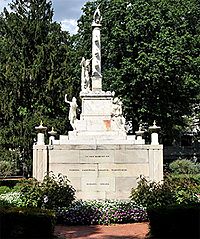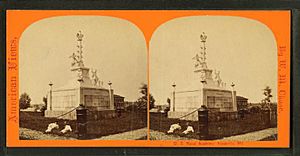Tripoli Monument (sculpture) facts for kids
Quick facts for kids Tripoli Monument |
|
|---|---|
| United States Naval Academy | |

Campus of the U.S. Naval Academy
|
|
| For the memory of Somers, Caldwell, Decatur, Wadsworth, Dorsey, Israel | |
| Unveiled | 1808 (sculpted 1806) |
| Location | 38°58′59″N 76°29′15″W / 38.98311°N 76.48759°W near the Officers' and Faculty Club
|
| Designed by | Giovanni C. Micali |
|
As a small tribute of respect to their memory and of admiration of their valour so worthy of imitation their brother officers have erected this monument.
|
|
The Tripoli Monument is the oldest military monument in the United States. It honors brave heroes of the United States Navy. These heroes fought in the First Barbary War (1801–1805). They include Master Commandant Richard Somers, Lieutenant James Caldwell, James Decatur, Henry Wadsworth, Joseph Israel, and John Sword Dorsey.
This special monument was carved in Livorno, Italy in 1806. It was brought to the United States on a famous ship called the USS Constitution, also known as "Old Ironsides." The monument was first placed in Washington, D.C. in 1808. Later, it moved to the United States Capitol in 1831. Finally, in 1860, it found its home at the United States Naval Academy in Annapolis, Maryland.
Contents
What the Tripoli Monument Looks Like
The Tripoli Monument is a tall, white marble sculpture. It stands about 30 feet high. An eagle sits at the very top of a column. The column rests on a detailed base. This base has figures that represent important ideas. These figures are Glory, Fame, History, and Commerce.
Understanding the Monument's Figures
- History: On one corner, a seated female figure holds a book and a pen. She looks up, ready to write down the brave events she sees.
- Commerce: On another corner, a male figure points to the column. He holds a caduceus, which is a symbol for trade.
- Winged Victory: This figure stands next to the column. She holds a laurel wreath over a stone coffin, called a sarcophagus. She also holds a palm branch, both symbols of victory.
The column itself has two rows of ancient "beaks of galleys." These are like the front parts of old warships. It also has two rows of anchors carved into it. The whole sculpture sits on a square stone base. There is a decorative urn on each corner of this base.
Materials and Other Names
The monument is made from beautiful Carrara marble. Its base is made of sandstone. It measures about 30 feet tall and 16 feet wide. People also know this monument by other names. These include the U. S. Naval Monument, the Naval Monument, and the Peace Monument. The artist who designed it was Giovanni Charles Micali. He signed his work in 1806.
Messages on the Monument
The Tripoli Monument has several important messages carved into its base. These words help us remember the heroes it honors.
Artist's Signature
On the north side of the monument's base, you can find the artist's signature. It says, Giov. Charles Micali Invento·In Livorno 1806. This means Giovanni Charles Micali designed it in Livorno, Italy, in 1806.
West Side Inscription
The west side of the monument's base has this message:
The love of Glory inspired them
Fame has crowned their deeds
History records the event
The children of Columbia admire
And commerce laments their fall
This inscription means that the heroes were inspired by a desire for honor. Their brave actions made them famous. History will remember what they did. The people of America admire them, and trade is sad about their loss.
East Side Inscription
On the east side, the monument says:
As a small tribute of respect to their memory
and of admiration of their valour
so worthy of imitation
their brother officers
have erected this monument
This message explains that the monument was built by their fellow officers. It is a small way to show respect and admiration for their bravery. Their courage is something others should try to copy.
South Side Inscription
The south side of the base lists the names of the heroes:
Erected in the memory of Captain
Richard Somers, Lieutenant
James Caldwell, James Decatur,
Henry Wadsworth, Joseph Israel,
and John Dorsey who fell in the different
attacks that were made on the city of Tripoli
in the Year of our Lord 1804
and in the 28 year of the independence
of the United States
This part clearly states that the monument remembers these specific officers. They died during attacks on the city of Tripoli in 1804. This was 28 years after the United States became an independent country.
Bottom Base Inscription
On each side of the larger bottom base, it simply says:
TO THE MEMORY OF
SOMERS, CALDWELL, DECATUR, WADSWORTH,
DORSEY, ISRAEL
This makes sure everyone knows who the monument is for.
Historical Plaque Near the Monument
A brass plaque was placed near the monument after it was fixed in 2000. It gives more history:
THE TRIPOLI MONUMENT The oldest military monument in the United States honors heroes of the War against
the Barbary Coast Pirates, the new republic's first war. In 1804, President Jefferson ordered
the nation's tiny naval force to the Mediterranean to protect the expanding trade of the new
United States against the pirates, who demanded ransom for safe passage of merchant ships.
"Millions for defense, but not one cent for tribute" became the rallying cry for this war.
Jefferson's action established the doctrine of extension of power overseas and created
a permanent United States Navy.
This plaque explains that the monument honors heroes from America's first war. This war was against pirates who demanded money from ships. President Jefferson sent the Navy to protect American trade. The phrase "Millions for defense, but not one cent for tribute" became a famous saying from this time. This war also helped create a permanent United States Navy.
Journey of the Tripoli Monument
After the First Barbary War ended in 1805, Captain David Porter of the U.S. Navy decided to create a monument. He wanted to honor the officers who had died. Captain Porter worked with the Bishop of Florence, Italy. They asked Giovanni Micali to create the monument for $3000. This was half of Micali's usual price.
From Italy to Washington, D.C.
The monument was finished in 1806. It then traveled across the Atlantic Ocean to Newport, Rhode Island. It sailed on the famous ship USS Constitution, also known as "Old Ironsides." From Rhode Island, it was shipped south to the new capital city, Washington, D.C..
It took some time to gather money to put the monument together. Finally, in 1808, it was placed at the Washington Navy Yard. This was on the banks of the Anacostia River. It was called the Naval Monument at that time.
Damage and Moves
During the War of 1812, British soldiers attacked Washington in 1814. They damaged the monument. But it was later fixed. In 1831, the monument was moved again. It went to the United States Capitol building. Captain Porter was not happy with its new spot. He said it was placed in a "small circular pond of dirty fresh water." He felt this did not properly represent the Mediterranean Sea.
Finding a Permanent Home
In 1860, the monument was moved one last time. It found its permanent home at the United States Naval Academy in Annapolis, Maryland. Even at the Academy, it was moved a few times as the campus grew. Today, it stands proudly in front of the Academy's Officers' and Faculty Club.
In 1994, experts noticed the monument needed repairs. A big restoration project was completed in June 2000. Some people think that the figures of Glory, History, Commerce, and Fame might not be in their original positions. They might have been moved around when the monument was first set up at the Capitol in 1831.


